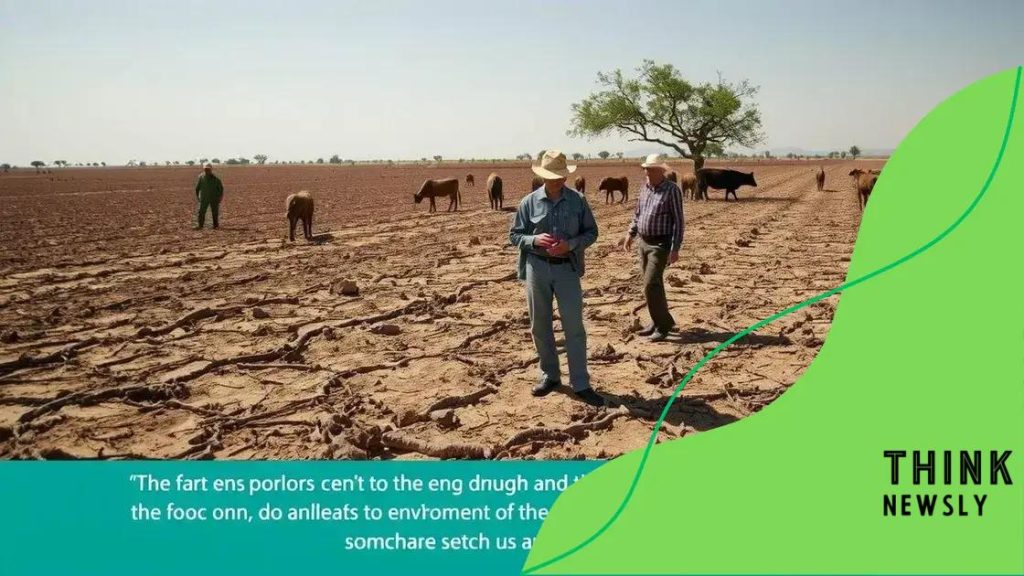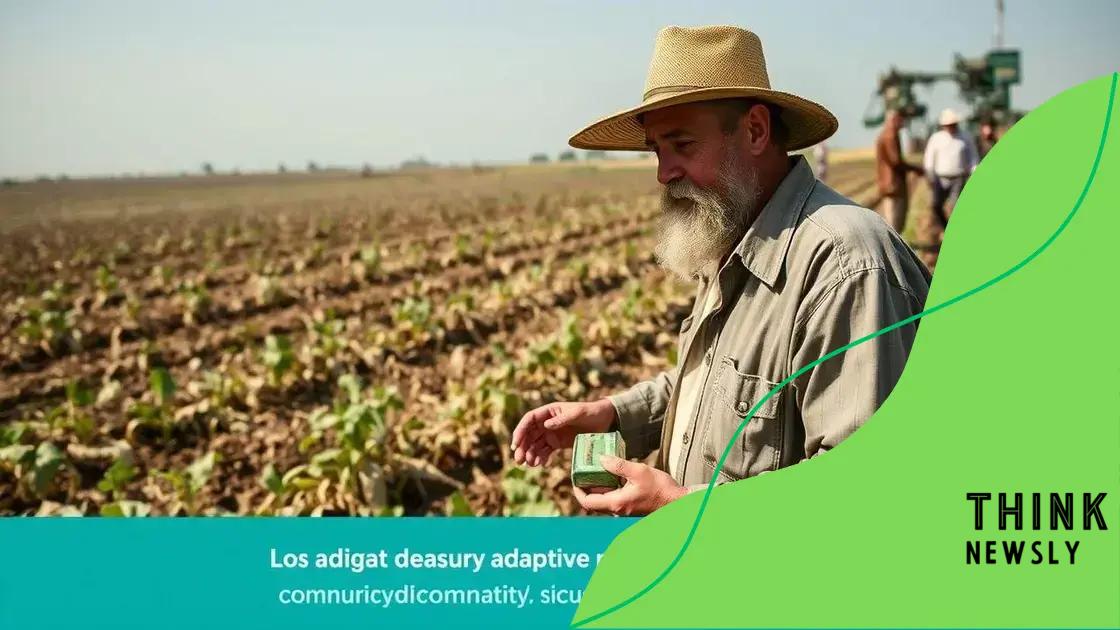Federal drought plan enters phase two: what to expect

Anúncios
The federal drought plan addresses severe water scarcity by providing essential strategies, resources, and support for farmers and communities to manage and adapt to drought conditions effectively.
Federal drought plan enters phase two, which means significant changes are underway. Have you considered how these adjustments might influence your community and agriculture? Let’s dive into what’s new.
Anúncios
Understanding the federal drought plan
Understanding the federal drought plan is crucial for communities affected by water scarcity. This plan outlines the strategies the government uses to address severe drought conditions and ensure resource availability.
The plan is divided into various phases. Each phase has specific objectives and actions that adapt to the changing needs of those impacted. In this section, we’ll explore the core components of the drought plan and what they mean for various stakeholders.
Core Components of the Federal Drought Plan
This plan focuses on several key areas:
Anúncios
- Monitoring drought conditions using scientific data to make informed decisions.
- Resource allocation to ensure that water supply is prioritized for essential needs.
- Public assistance programs that support farmers and communities in crisis.
- Collaboration with state and local agencies to implement effective measures.
Additionally, the federal drought plan emphasizes future preparedness. This involves creating frameworks that promote long-term sustainability and resilience against climate change impacts. Programs are developed to enhance water conservation and management techniques.
Incorporating community feedback is another vital aspect. Stakeholders, including farmers, local governments, and residents, contribute to the plan’s evolution. This collaboration ensures that diverse needs are considered, leading to more effective drought solutions.
Key changes in phase two of the plan
Key changes in phase two of the federal drought plan bring significant updates that can impact many sectors. This phase aims to enhance response strategies and allocate resources effectively.
One of the primary changes involves increased funding for drought relief programs. This funding will help farmers and communities to cope better with water shortages. Furthermore, the government plans to prioritize addressing vulnerable regions that are most affected.
Increased Monitoring and Data Collection
Another crucial update in phase two is the enhancement of monitoring and data collection efforts. Improved technology will allow for better drought predictions and resource management. This will ensure timely responses and improved planning for future droughts.
- Real-time data on water levels and weather patterns.
- Utilization of satellite technology for comprehensive assessments.
- Collaboration with local agencies for better reporting.
- Feedback integration from affected communities to refine data.
Additionally, outreach programs will be established to educate communities on drought resilience. These programs will focus on practical measures that individuals and businesses can take to conserve water. By promoting awareness, the government hopes to foster a community-driven approach towards drought management.
Enhancements in infrastructure are also part of the new phase. Investment in water storage solutions and efficient irrigation practices will be prioritized. This will help maximize water usage during dry spells and support agricultural sustainability.
Impact on farmers and agricultural practices

The impact on farmers and agricultural practices due to drought conditions can be significant. Drought can lead to reduced crop yields, soil degradation, and increased operational costs. Farmers must adapt to these changing conditions to sustain their livelihoods.
As resource availability decreases, farmers face challenges in maintaining their usual production levels. Many are forced to alter their planting schedules, switch to more drought-resistant crops, or adopt new farming techniques to conserve water.
Adaptation Strategies for Farmers
Transitioning to new methods is essential for survival. Here are some adaptation strategies:
- Implementing drip irrigation systems to maximize water usage.
- Using cover crops to improve soil moisture retention.
- Practicing crop rotation to enhance soil health.
- Participating in government-sponsored drought relief programs to seek financial support.
These strategies can help mitigate the effects of drought on farming operations. By embracing innovative methods, farmers can improve sustainability and resilience against future droughts.
Furthermore, community involvement plays a crucial role in supporting agricultural practices. Cooperative efforts among farmers can lead to sharing resources and strategies, ultimately strengthening the local agricultural economy. Workshops and training sessions can provide essential education on best practices and drought management.
As the federal drought plan evolves, it becomes increasingly important for farmers to stay informed about available resources and funding opportunities. Keeping in touch with agricultural extension services can provide valuable insights into the latest developments that may benefit their operations.
Government support and resources for affected areas
Government support and resources for affected areas play a vital role in managing the effects of drought. These initiatives aim to help communities, especially farmers, cope with the challenges that arise during dry periods.
One significant type of assistance is financial aid, which helps those most impacted by drought. This support can come in various forms, such as grants, low-interest loans, and subsidies for water conservation efforts.
Types of Government Assistance
Some key types of assistance include:
- Emergency funding for immediate relief needs
- Loan programs that help farmers cover operational costs
- Grants for sustainable practices to improve long-term resilience
- Training and workshops that educate producers on water-saving techniques
Additionally, the government provides resources through practical programs that promote effective drought management. These programs help farmers implement new technologies and strategies to better utilize water resources.
Collaboration with local agencies is essential as well. Federal programs often work closely with state and community organizations to identify specific needs and tailor responses accordingly. This localized approach ensures that resources are used where they can have the greatest impact.
Throughout the phases of the federal drought plan, it is crucial for communities to stay informed about available assistance. Regular updates on funding opportunities and resources are often provided through government websites and local agricultural offices. Engaging with these updates can empower affected residents to take advantage of the help available.
Future outlook for drought management
The future outlook for drought management is shifting as climate change continues to impact weather patterns. This evolving situation requires updated strategies and innovative solutions.
One key aspect is the incorporation of improved technologies. For instance, advancements in weather forecasting and irrigation systems will play a vital role in how farmers and communities prepare for drought conditions. These technologies can provide real-time data to help manage resources better.
Innovative Approaches to Drought Management
Several emerging practices are gaining traction:
- Water conservation techniques: These include methods such as rainwater harvesting and soil moisture sensors.
- Climate-resilient crops: Developing and using crops that can withstand dry conditions will become increasingly important.
- Community engagement: Involving local populations in water management decisions ensures that their needs and knowledge are considered.
- Financial planning: Setting up funds for unexpected droughts can help farmers and communities respond more effectively.
Educational programs also play a critical role in preparing communities for future droughts. By raising awareness of sustainable practices and resource management, these initiatives help build resilience. Workshops and training can empower local leaders, equipping them with the tools necessary to adapt to changing conditions.
Furthermore, collaborative efforts between governments, researchers, and local stakeholders will be essential. Sharing data and resources can lead to more effective responses and broader resource conservation efforts. As a result, enhancing partnerships will become key in addressing the complex challenges posed by future droughts.
The future of drought management requires collaboration, innovation, and education. By implementing advanced technologies, farmers can better withstand changing climate conditions. Engaging communities and providing support through government resources will enable individuals to adapt and thrive despite water scarcity. It is crucial to prioritize sustainable practices to ensure food security and environmental preservation. Together, these efforts can create a more resilient agricultural landscape for the future.
FAQ – Frequently Asked Questions about Drought Management
What is the federal drought plan?
The federal drought plan outlines strategies and resources to address drought conditions, helping communities and farmers manage water scarcity.
How can farmers adapt to drought conditions?
Farmers can adapt by implementing efficient irrigation systems, using drought-resistant crops, and participating in government support programs.
What role does technology play in drought management?
Technology helps improve weather forecasting, water usage monitoring, and crop management, making it easier for farmers to respond to drought conditions.
How does government support aid affected communities?
Government support provides financial aid, resources for sustainable practices, and education to help communities and farmers recover from drought impacts.





